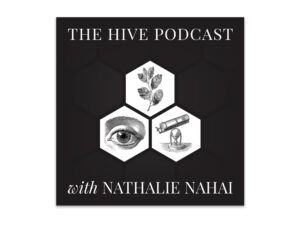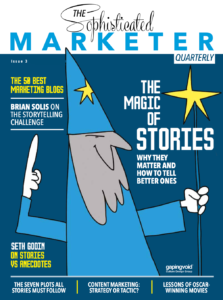I’m frustrated that my worth is measured more by the numbers of followers, views or visitors that I have and not the merit or impact of my work. You too must start to feel discontent when it comes to your work being judged on hollow numbers alone. The ability to cause effect or change behavior is true influence and that’s the core of what we stand for.
Numbers do not mean much. Without purpose and intention, our work becomes part of the noise and not the signal. It’s easy to fall into this trap though as all day today, you’ll get stuck in meetings where you’ll question the value of why you’re even there, flounder as you try to swim upstream in a relentless stream of email and fall into rabbit holes of introspection as politics, egos and general ignorance force you to re-examine where you are and where you’re going.
There’s just no time or real support to change but that doesn’t mean change isn’t inevitable.
In marketing, there are always trends that people will follow and others will miss. The trick is to not fall into a pattern of mediumism where we place greater value on the channels over native engagement and experiences. The goal most overlook however, and this must change, is the need to earn human relevance and not meaningless numbers. While some people yell “fire!” (although rightfully so in most cases) and point fingers at others, you and I will focus on developing strategies and creating content that engages AND adds value. As in life, investing in experiences and moments where people leave with something (you decide) contributes to relevance and reciprocity.
Meta 2.0: The New Storytelling
To demonstrate this point, I recently went a bit meta and worked on a content marketing campaign designed to help marketers improve content marketing campaigns. In a new, fun ebook I worked on with LinkedIn’s Jason Miller and Hugh MacLeod of GapingVoid. Our goal was to help content strategists and marketers enhance audience engagement by rethinking the approach to content and community engagement.
Storytelling in its truest sense is more important than ever. Yet, we misconstrue the opportunity to tell a sincere story with creating and broadcasting content that barks messaging across social networks without really embracing or even knowing the people formerly known as the audience. Instead, we often create for the people who approve our work rather than sincerely empathizing with those people who have an audience with an audience of their own. It’s our agenda or nothing right?! Wrong.
Humans are emotional creatures and they want experiences that engage them as humans. They’re not eyeballs, impressions, views, likes, shares, clickthroughs, or conversions. And, it is through empathy that we can design for “Limbic Resonance” to engage people emotionally and to plug-in to social graphs as a human distribution network for our story. By doing this over and over again, we can connect people through sharing and conversation to form communities that we can then cultivate.
That takes understanding, purpose, intent and genuineness not campaigns measured by vanity metrics.
LinkedIn has made this ebook freely available and we hope that it inspires you as much as it inspired us to think differently. You can download it here.
In the end, do everything in ways that are culturally relevant, meaningful, shareable and form the ties that bind the right people together.
Connect with me… Twitter | LinkedIn | Facebook | Youtube | Instagram | Pinterest









You and I usually are quite well aligned, Brian, but in this case I feel your link to Josh’s blog post (which references mine) misses the point.
We all agree that “true engagement is not something you sell,” but “sell” is the reason the Marketing Department exists in most organizations, and “sell” is how Marketing measures its success (via metrics like acquisition, inbound traffic, conversions and, in fact, sales.) As a result, the question I raised in my blog post (and Josh feels I didn’t take far enough) is if storytelling and brand content can deliver on the goals of the Marketing Department. As my blog post suggests (validated with volumes of data and links), the use of social and organic content will not be able to drive the outcomes the Marketing Department wants and expects.
We can debate if Marketing should have different goals or not, but the bottom line is this (and I think you’ll agree): Between shrinking reach, low consumer trust, active consumer blocking of brand messaging and rising paywalls on social networks, the key to social media success isn’t brand content but true peer-to-peer WOM. We need to get consumers talking about the experiences our brands provide, not the content they create.
In a world where Coca-Cola–a brand that engages with consumers 1.8 BILLION times a day with its product–can only reach 38,000 people in a week on Facebook and on Twitter can only occasional engage more than 1,000 with a tweet, it should be evident the secret to success isn’t better posts and tweets FROM the brand but more posts and tweets ABOUT the brand from customers.
I tend to think we are more aligned than not, but if you truly think Marketing Departments can invest in content to gain organic reach and deliver on business objectives that justify the investment, then I’d like to see your data. I’m not talking about the rare case study where a brand puts money down on the roulette wheel and strikes it lucky–I mean the broad data that demonstrates all brands can generate value from the content they post to social networks. I’ve yet to see data that proves this, but I’m always open to having my POV challenged. It will take more than accusing me of yelling “fire” to do this, however.
Augie if I’m not mistaken, it wasn’t you who yelled fire…that’s why I didn’t link to the original post. And yes we are in agreement. That’s the point of my post. Content marketing, social and vanity metrics are often part of the noise not the signal. I say so much. And if you look at many of my posts over the last 10 years, you’ll see I’ve said the same thing 1000 different ways. I even have a name to define it…”mediumism.”
In regards to your point on data, I’ve personally run social and content programs as both campaigns and experiments with organic reach yielding significant ROI and have since I started a company to do just that for startups and brands in 1999. I still run those experiments today for companies as a way of learning about digital influence. That’s how I get my knowledge to right reports about it…otherwise if I rely on brands to tell me their case studies, I wouldn’t get much.
I would’ve been surprised had we been in disagreement. I appreciate the response and the additional perspective.
cheers augie!
btw. for those who want a good read and to see why Augie and I are in agreement in many ways, please read his post on the subject…
His title says it all: http://www.experiencetheblog.com/2015/08/burn-it-down-start-from-scratch-and.html
There is a meatball sundae here.
When you click through, you get one of those old-fashioned “download a sales call” forms which insists you even give your phone number and quarterly advertising budget just to get the e-book. Epic FAIL when you are talking about the value of attention.
here you are sir…
https://www.slideshare.net/afvh/attention-is-a-currency-by-linkedin-featuring-brian-solis-gaping-void?ref=https://twitter.com/i/cards/tfw/v1/636553747796262912?cardname=player&earned=true
I never thought of my posts being sharable and binding people together. Marketing should be more about the content rather than anything else because without great content people are not going to engage and untilmately the compaign will fail. Consumer engagement is a clear goal that should be considered for all marketing companies.
we can’t just think about it as content…that’s simply an artifact. it’s how you turn it into a social object that matters. 🙂
Being genuine and transparent is the new way for campaigns these days, I agree. We have begun the shift from “loudest and proudest” to more of a brand journalism role that is meant to share a story and connect with the customer, rather than shoving our products in their faces as many times as possible. The challenge is not trying too hard to be sentimental or else it will come off as just the opposite. I am tired of brands thinking they know what is best when now it is a give and take relationship. Our opinions are now just as important as theirs. So brands need to connect with their audience so they can grow and evolve with their audience.
Thank you for the comment.
I completely agree it’s easy to miss the need for relevance and focus too much on just getting the numbers. I have certainly noticed a storytelling trend begin to emerge that capitalizes on the audiences emotions in order to engage them, and personally I find this strategy to be the most effective when I’m being marketed to. I look forward to reading the ebook to see your advice on improving content marketing campaigns. Enjoyed your post!
Thank you Laurel!
I love the part when you said that “numbers do not mean much”. Truly, it is the intent and purpose that counts. I like also the aspect of hitting the emotion of humans…